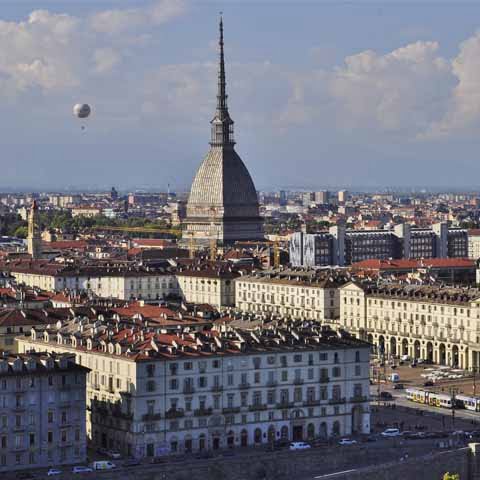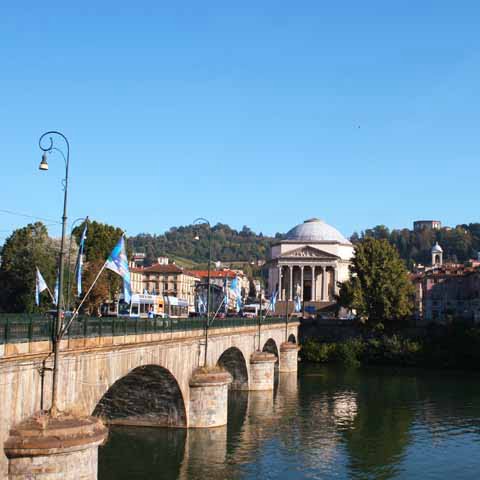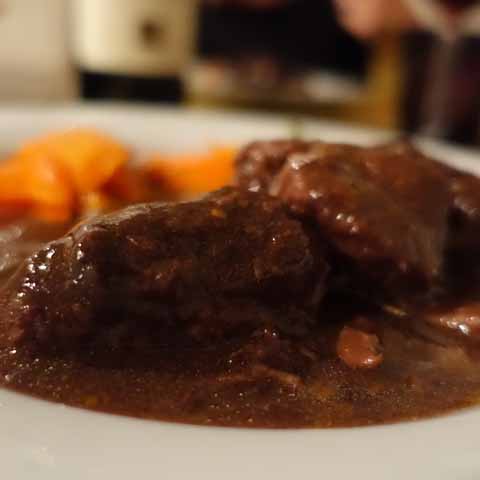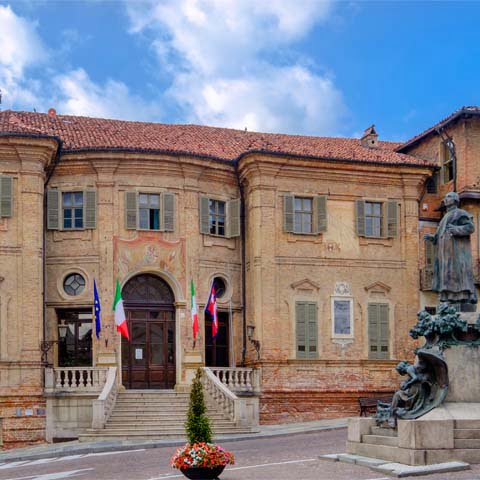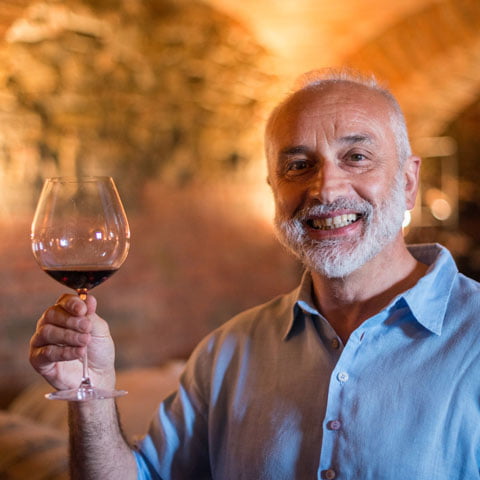Piedmont is an Italian region suitable for all types of activities. Rich in rolling hills, beautiful mountains, and sweeping plains, with vast Alpine stretches and wonderful rivers and lakes, this land offers the chance of enjoying breathtaking nature, practicing various sports or discovering some unique and fascinating places.
The region is surrounded by both the Alps and the Apennine mountains, preferred destinations of the skiing and winter sports enthusiasts. The main hilly areas are Canavese, the Langhe, Monferrato, and Roero, places characterized by endless vineyards and well-groomed slopes, orchards, and splendid countryside.
Apart from offering numerous outdoor entertainment opportunities thanks to its rich natural landscape and resources, Piedmont is also a region characterized by a vast artistic and cultural patrimony shared by the main cities of the region.
Throughout the various cities and towns, it is easy to discover splendid Romanesque, Gothic, Baroque, Neoclassic and contemporary art and architecture.
The region is also famous for an exquisite cuisine, while the wines of the region taste simply heavenly. All year round, the various towns, cities, and boroughs host many cultural events and food festivals, called sagre, where it is possible to taste the genuine foods of Piedmont.
From the numerous festivals and events hosted in the region, the Carnival of Ivrea stands out. This carnival is the one of the few in the world to have a precise plot, to tell a story whose characters are not puppets, but real characters and symbols of libertarian values.
The carnival is an interpretation of ancient events, and although the original plot of the legend has been adapted through various and complex stratifications to address an audience of different ages, the narrative still maintains the flow of the real events.
The origins of the carnival date back to the Middle Ages and are a symbol of the people’s fight against oppression. The original popular uprising is now represented by the famous Battle of the Oranges that, despite its symbol, attracts many enthusiasts each year.
Another popular event in Piedmont is Palio di Asti, a horse race held every year since the 12th century in honor of San Secondo, the patron saint of the celebration. Just as the carnival, the race also has ancient roots and it is unique in its genre because the horses are mounted without a saddle.
Originally, the race took place on March 30th on the occasion of the Festival of San Secondo. Nevertheless, in the early 19th century the date of the event was changed to the second Sunday after Easter and is now held on the third Sunday of September.
Another important event usually held throughout the month of October and that attracts many food lovers and wine enthusiasts is the International White Truffle Fair in Alba. The truffles are a special type of mushroom that grows under the ground and consist of an external capsule and an internal mass of variable color that allows the identification of the species. The truffles of Piedmont were considered one of the most desirable foods among the European nobles since the 17th century, in particular the white truffles of Alba, which are harvested in the territories of Langhe, Monferrato, and Roero.
Truffles are relatively rare and, being particularly appreciated, they can be rather pricey. During the Fair, Alba becomes the world capital of truffles and the town hosts countless events including food tasting, cooking classes, truffle auctions, and many other interesting cultural events.
Another important event held in Alba is the Wine Festival, usually held in September. During this festival, the historic center of the town transforms into a “wine route” where participants can taste some of the best local wines of Piedmont.
Many other boroughs and towns throughout Piedmont hold harvest festivals and local sagre focused on food and wine, but accompanied by music and cultural events. These celebrations are a good way of discovering the local traditions and culture related to vineyard work, tasting, and folkloristic stories.
During fall, those in Piedmont can attend numerous seasonal activities that include truffle hunting, grape harvesting and winemaking, cooking classes, and more.
By far, the most popular activity is the truffle hunting. Commonly, truffles are the fruiting body of mushrooms that grow underground. They are usually identified with the help of trained dogs and are hand-picked.
The truffles are an extremely valuable and sought-after food appreciated since the first century AD. Truffles are relatively rare because their growth depends on seasonal and environmental factors, factors that justify the stratospheric prices.
Nevertheless, Italy is one of the world’s largest producers and exporters of truffles, and these precious mushrooms are used in many local dishes, and not only in Piedmont but in many other areas, such as Tuscany or Emilia Romagna. Thanks to this original addition, many simple dishes transform into elaborate recipes.
Piedmont is home to the world’s most valuable variety of truffles, the Tuber Magnatum Pico, also known as the white truffle of Alba. Apart from this rare and expensive variety, the region boasts many other varieties that usually grow in the hilly areas between the Langhe, Monferrato, and Roero. Many of these varieties have more affordable prices, and many associations from the region organize truffle hunting expeditions that culminate with fairs and events dedicated to the precious food.
Apart from the International White Truffle Fair of Alba we mentioned above, other fairs worth attending are the National Fair of Moncalvo in the province of Asti, and the White Truffle Auction at Grinzane Cavour, in the province of Cuneo.
As far as the mushrooms are concerned, Piedmont is characterized by a peculiar abundance of many other types of surface mushrooms. In the rural areas, the communities usually organize mushroom picking expeditions, especially in Giaveno and Val Sangone, which are areas that are abundant in porcini mushrooms.
Wine harvesting is also transformed into cultural events, and there are many seasonal activities to attend. Most wineries open their gates to guests who are willing to live the winemaking experience, allowing them to harvest grapes and attend the winemaking process.
The events usually include wine tastings, wine and food pairing lessons and more.
Those interested in outdoor activities are delighted to know that Piedmont is a perfect place for enthusiasts of hiking or winter sports, such as skiing.
From spring until late fall, Piedmont is perfect for hikers who enjoy walking along the beautiful panoramic trails. The rich network of trails features beautiful valleys, enchanting mountain lakes, natural parks, and even traces of art and culture among fortresses, sacred mountains, and alpine villages.
For the lovers of wild areas and uncontaminated nature, the National Park of Val Grande offers a total immersion in the wilderness of the Alps. On these trails, you will be able to explore large beech tree forests and admire amazing landscapes.
Other attractive hiking routes lead to the discovery of typical villages. One of the most evocative is Orta San Giulio, on the Lake Orta, in the province of Novara. The settlement is characterized by a multitude of palaces dating from the medieval times with open loggias and splendid gardens. Piazza Motta, full of shops and cafes, is the lively center of this small village, while at only 400 meters away from the shore, you can visit the unique Island of San Giulio.
In the province of Turin, a village that stands out is Usseaux. The landscape and architecture of this settlement are unique and characterized by stone and wood houses, public wash basins, fountains, and more. The façades of the buildings and the walls of the city are decorated with murals depicting scenes of the peasant life, nature, animals, and fairy tale characters.
At 1800 meters of altitude, located in the province of Cuneo and on the border with France, Chianale is another quaint mountain village characterized by lodges made of stone and wood. The landscape will surely impress, while the potato gnocchi served with grated cheese and melted butter will delight even the most discerning taste buds.
In the same province, another beautiful village to discover while hiking is Ostana, a small hamlet located in the Valley of Po that offers mesmerizing views over Monviso. The hamlet itself is amazing and its aspect is pretty much the same from a century ago. Here you will find communal bread ovens made of stone, cobblestone streets, ancient chapels and the tasty local dish of polenta with buckwheat.
In winter, the main activity of the region is skiing, and there are numerous resorts located close to the major cities such as Turin, Cuneo, and Biella.
The ski resorts closest to Turin are Col del Lys and Pian Neiretto, both of them at less than half an hour’s drive from the city, inside the Orsiera-Rocciavrè Natural Park and overlooking the Valley of Sangone. Without a doubt, these resorts are the right destination for those who love to ski in a peaceful area, without long lines or too many people on the slopes. In the Turin area, for those who love famous and renowned slopes, the Sestriere is a must, with its charming city center.
The Valley of Susa is another destination renowned among skiers and is one of the places where competitions were held during the Turin Olympics in 2006. The best resort for families and snowboarders is Pian del Frais.
Among the Valleys of Cuneo, a popular destination is Limone Piemontese with beautiful slopes exposed to the sun yet sheltered from the wind.
Lastly, the Valleys of Biella and the Valleys of Canavese offer skiing in Piedmont with a number of slopes of different difficulties, so there is a slope suitable for novices and experts alike.
Piedmont is a region rich in culture and it boasts numerous museums related to art, local crafts, and even local products. Moreover, the region also boasts a rich cultural heritage and has an impressive number of castles, abbeys and churches.
For those that enjoy museums, perhaps the most important to visit is the Egyptian Museum in Turin, considered the most important Egyptian museum in the world after the museum of Cairo. The notable exhibits include a collection of over 30.000 artifacts relevant to the Egyptian culture.
To discover more about the culinary culture of the area, an alternative museum to visit is the WiMu in Barolo. Hosted inside the Barolo Castle, the museum offers a comprehensive insight into the winemaking culture of Piedmont and in the enchanting atmosphere of this place you will also be able to attend a wine tasting or a wine and food pairing course.
Mole Antonelliana is one of the most iconic monuments in Turin and the symbol of the city. Besides this, it is also the place where you can visit the National Museum of Cinema. The peculiar shape of the edifice is unique in the world and it is the result of the typical revolutionary style characteristic of the creativity of Alessandro Antonelli.
Another representative example of architecture in Turin is the Royal Palace, the first and most important residence of the Savoy in Piedmont. The palace represents the court of Savoy, a symbol of the power of the dynasty and, together with the surrounding gardens and other real estate belonging to the family, it has been integrated into a part of edifices declared as world heritage sites by UNESCO.
The Chapel of the Holy Shroud is one of the most important landmarks in Turin and an attraction for pilgrims and curious tourists alike. The chapel was commissioned by Duke Charles Emanuel of Savoy to preserve the precious Shroud, and it is located between the ducal palace and the Cathedral of Saint John.
The Royal Castle of Racconigi, located in the province of Cuneo, is a neoclassical castle that preserves its 18th-century charm and that is surrounded by a splendid French garden bordered by a long and thick wall.
Sacra di San Michele is one of the most scenic monuments of Piedmont and a true symbol of the region. Perched on the top of a mountain and dominating the Valley of Susa, the edifice has an unmistakable and impressive profile.
Built in the Romanesque style, the edifice is one of the largest religious buildings in Europe and preserves valuable frescoes, sculptures, and artworks.
This is just a few of the many museums and sightseeing locations in Piedmont, and many other landmarks are waiting for the curious to discover them.
Developing under the rule of the Savoy, the city of Turin evolved around the necessities of the nobility. Under the arcades and porticoes initially used as promenades by the noble class, today are housed many shops that boast Italian fashion, antique bargains, vintage shops, and souvenirs.
The high fashion boutiques are located along the historic and elegant Via Roma and on its parallel streets, Via Lagrange and Via Carlo Roberti.
Lovers of vintage antiquities and handicrafts can shop in Via Po, featuring numerous shops and boutiques that sell clothing and decorative items.
The local markets are a great way to shop and get in touch with the local culture. In Turin, each district of the city hosts local flea markets, such as the one of Porta Palazzo which takes place on Saturdays.
Vintage della Gran Madre is a retro-fashioned market that takes place in the historic center of Turin, near the splendid church of Gran Madre. The market, as its name suggests, is full of vintage clothes, jewelry, and other vintage items.
Reading enthusiasts should visit the market Il Libro Ritrovato, a book market where it is easy to find rare books and many collectible items.
Apart from Turin, throughout the region are held many local markets where it is easy to experiment the vibrant lifestyle characteristic to northern Italy.
Those that desire to have a unique experience in Piedmont should be happy to know that there are many activities to choose from and unique places to see.
A time-traveling experience guaranteed to entertain adults and children alike is a journey with the historic train of Val Tanaro that links Turin to Ornea. In this vintage train, time seems to have stopped at least a century ago, while the railway passes through amazing sceneries and unforgettable landscapes.
A visit to the Boromee Islands on Lake Maggiore is another fabulous experience. The three islands are very different from one another from an architectural and landscaping point of view.
In Piedmont, attending a wine tasting is easy, but if you want to live a wine tasting experience with a twist go to an Infernot, a unique cellar carved in limestone where wine is preserved perfectly throughout the years. These type of cellars host many wine tasting and culinary events unique to Piedmont.
Vacations To Piedmont –


